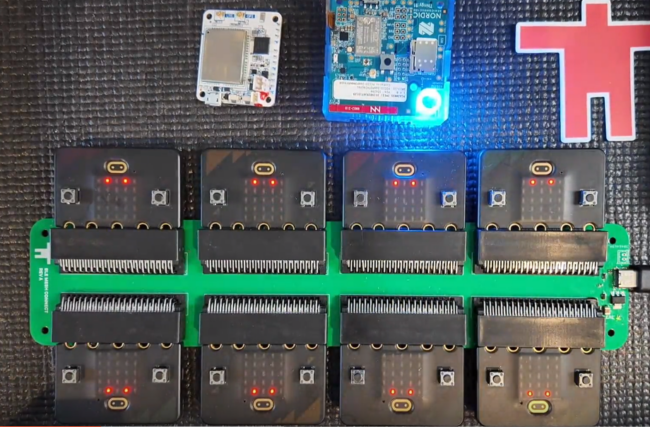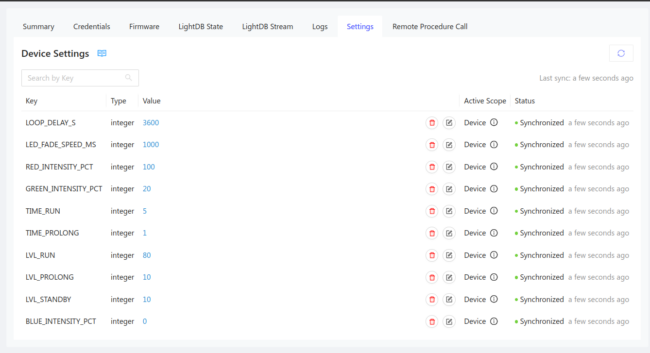We have been building Bluetooth® Mesh (hereafter referred to as “BT Mesh”) products for a long time. In fact, we helped write some of the BT Mesh models for Nordic, so we are very familiar with it. However, we’ve always been dependent upon applications written for phones to control the BT Mesh, which can be limiting while doing Mesh development or putting together quick prototypes for potential customers. This particular demo allowed us to add network connectivity by building on top of Golioth’s Thingy91 demo, which unlocks a faster design iteration cycle when it comes to BT Mesh. We asked Chris to help record the demo video above.
Controlling from afar
This demo shows that Golioth can control a BT Mesh-based lighting system where each of the individual components (nodes in the mesh) of the lighting system, (e.g., switches, luminaires, sensors), contain a BLE SoC. Normally a user must be within a few tens of meters of a Bluetooth device to interact with it using (for example) a mobile app on a smartphone. But instead, we show Golioth connecting via LTE-M cellular service to a Nordic Semiconductor Thingy91 (combined nRF9160 cellular modem and nRF52840 BLE SoC) which then communicates to the rest of the Bluetooth mesh, thus allowing an authorized user from anywhere on Earth to control the lights (represented in the demo by a series of bbc:microbits). This gives the user control over all aspects of the Mesh servers – sending commands and updating settings without needing to be physically present.
How it works
The button on the Thingy91 is programmed to function as a simple on/off light switch. A much greater set of control functions for the BT Mesh comes from the Golioth web interface (Console). The demo shows a small sample of the kinds of control that can be accomplished using Golioth:
- Ramping up the LED level on the lights
- Defining the LED levels
- Setting the time to keep the LEDs at those levels before ramping down
- Overriding the LED level – preventing ramping
The Thingy91 contains an nRF9160 LTE-M chip and an nRF52840 BLE chip – this represents the bridge between LTE-M and the BT Mesh. The bbc:microbits contain an nRF52833 BLE chip, and represent the luminaires (Mesh lighting nodes). The Golioth SDK has been integrated into the code for the nRF9160, connecting the Thingy91 to Golioth. When a user executes a Remote Procedure Call (RPC) or sets a device setting, this information is sent via LTE-M to the nRF9160. That chip converts that information into opcode values sending it via UART to the nRF52840 chip. The nRF52840 then builds an appropriate Bluetooth mesh command and sends it to the Mesh network (wirelessly). Each lighting node on the network receives and executes the Bluetooth Mesh command.
In this demo, each lighting node (bbc:microbit) implements the Bluetooth Mesh LC server: an intelligent Lighting Controller. If the LC element on the lighting node receives a Generic On command, it ramps up its LED level to the configured lightness on value and maintains that level for the period of the configured run on time. After that time has expired, it will fade the light level to the configured prolong lightness level and maintain that for the configured prolong time. Then it fades the LEDs to the configured standby lightness level.
Each of these configurable lightness levels and times can be changed in the Device Settings.
Once these are set, an RPC can initiate the LC server control, or it can override the LC server and set an exact light level preventing the LC server from controlling the lights. Additionally, there is an RPC that will re-enable the LC server.
Other applications
This demo gives just a taste of the control that Golioth can provide with the Bluetooth Mesh. In addition to lights and switches, many different classes of devices can be on a Mesh:
- Burglar and fire alarms
- Smart locks
- Thermostats
- All kinds of sensors (e.g., temperature/humidity, photometry, motion, power, environmental, …)
- More!
Commands can flow from the Cloud to each device, and status can be returned to the Cloud (e.g., alerts, alarms, etc.) Are the warehouse doors locked and the burglar alarm set? Well let’s check Golioth – oops, still unlocked! Let’s fix that. OK, Golioth just locked the front door, verified the locked status of the other doors, and turned on the burglar alarm. And just for good measure, we checked that the current temperature and humidity are within acceptable parameters. We didn’t even have to leave home to do that.
Now that we have the ability to control all this from the Cloud, we’ve unlocked new designs for our customers, and we’re able to spin up test deployments faster than ever.




No comments yet! Start the discussion at forum.golioth.io